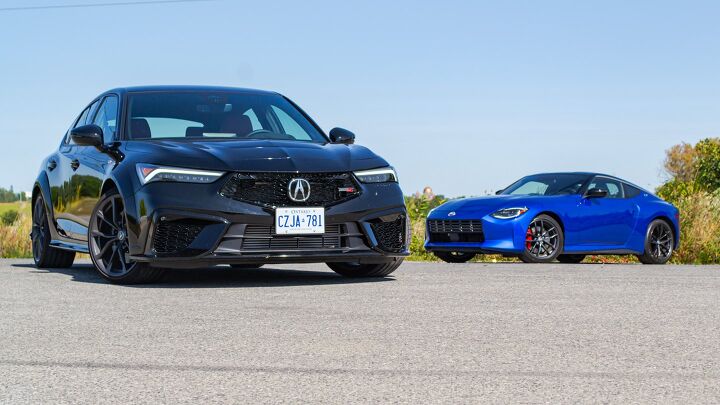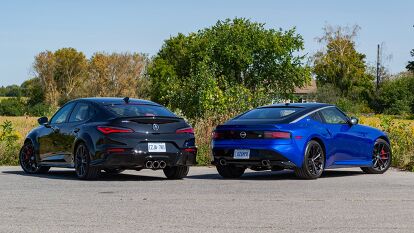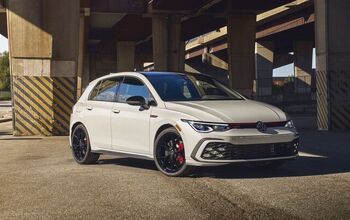Acura Integra Type S Vs Nissan Z Comparison


You’re an OG, I get it. You’ve got the back issues of Sport Compact Car and the prizes from the Fast and the Furious trivia nights to prove it—hashtag family.
But it’s been a few years since you’ve lived your life a quarter mile at a time, and you want to get back into a nameplate you admired from your youth. With about 50 grand to spend in the US (or 60-ish in Canada), you’ve got two very different enthusiast choices from Acura and Nissan.
They’re both turbocharged and blessed with honest-to-goodness six-speed manuals, but that’s about where the similarities between the Acura Integra Type S and the Nissan Z end. One is a front-drive four-cylinder, with genes from the Type R. The other is a classic rear-drive setup, with an additional pair of cylinders and a serious power advantage. One has four doors; the other sticks to two. Which one earns your hard-earned? Let’s find out.
[detroit-new-car id="new-car-quote" make="acura" model="integra"][/detroit-new-car]
Powertrain, Driving Feel, and Efficiency

Acura Integra: Blessed with the most powerful turbo-four Acura (or Honda) has ever shoved under a hood, the Type S throws down 320 horsepower along with 310 pound-feet of torque. Unlike the Z, it doesn’t even offer buyers the choice of an automatic: it’s the six-speed manual or nothing here. Not that it’s a problem, as this is the slickest, most satisfying manual you’re going to find anywhere shy of six figures. Short throws that dare you to be quicker and a friendly, progressive clutch pedal make the Type S a doddle around town and an ally out in the hills.
The suspension is firm enough to mean business, and yes, those steamroller 265s at every corner do provide a lot more road roar than any other Teggie. Keep the Integra in its default drive mode and it’s a speedy little thing, yet totally livable. Switch out to one of the others and the whole chassis wakes up. The adaptive dampers increase body control with no major penalty to ride quality, building confidence over the uneven, potholed surfaces of my usual drive roads. The Integra breathes with the road, but it never feels like it’s doing the work for you. Case in point: there will be torque steer if you’re too eager with the throttle, and the electronic nannies will only rein it in after you’ve had that brief reminder.

Pop over to Sport+ and the Integra rolls up its sleeves. The suspension tightens up even more, keeping the Integra touring-car flat through corners with a remarkably neutral balance. Throttle response is sharp, and the steering gains an additional bit of resistance. The Integra’s helm is positive and consistent, egging the driver to slice into the next apex even sharper than the last one. No front-driver has any business being this eager on turn-in; and really, nothing besides the Type R does it.
On paper the Type S is down a solid 80 ponies. I’m sure a timer would show it can’t beat the Nissan in a straight line, but it isn’t far off. The combo of light curb weight (3,219 pounds) and that quick-shifting six-speed allows the Integra to reel in corners at a serious clip. While this engine is working harder, it doesn’t act as turbocharged as the Z; instead, Acura’s done a commendable job remaking the VTEC rush for this decade, as the Type S gets a second wind to close in on that 7,000 rpm rev limit. All the while you get one of the better four-cylinder soundtracks on the market, a rich note and overlaid pops and bangs if you’re in Sport+. The enlarged Brembo brakes shed the speed just as well too, with a strong initial bite that only gets better with more pressure.

Nissan Z: No matter which Z model buyers opt for, they’ll find a 3.0-liter turbo V6 tucked inside that long nose. All but the Nismo trim push out 400 hp and 350 lb-ft, with the choice of either this six-speed manual or a Mercedes-based nine-speed automatic. The latter is fine for those seeking a sort of quasi-GT, but fans of tradition and interaction will gravitate towards the manual. It’s… fine. Probably good, if not for the contrast the Acura provides. The Nissan’s clutch is heftier but its bite-point is harder to pinpoint. Each throw requires a concerted effort, with some notchiness in the lateral movements. Nissan has fixed the 1–2 shift, but the Z’s box still prefers you don’t rush it. Like the Integra, there is rev-matching, accessible through a simple button on the center console.
The Z is loose-limbed after the poised and agile Acura. The combination of rear drive and a few extra hundred pounds translates to a softer driving experience, one with fuzzier limits. It’s hard to be as clean and concise with the Z, as the soft rear suspension can take precious time settling in over a series of off-camber corners. The steering, while well-weighted, lacks feedback, so you’re left relying on seat-of-the-pants feel only, and there’s a delivery delay when relaying messages between backside and hands. There are no adaptive dampers here either, so there’s no tightening up the slack. I get it: Nissan needed to find a healthy balance between daily grind and backroad blast. The result is a car happier at eight-tenths.

It is a blast in a straight line though. The V6 builds power with a noticeable step, waking up around 2500 rpm as the tail slightly squats and the Z straight scoots. It’s fun that Nissan hasn’t tried to hide the turbo nature. If only the manual had the sport exhaust the auto enjoys: the Z never really sings. The brake pedal is squishy, but the large discs themselves haul the Z up without issue.
Bottom Line: My personal tastes skew more towards the surgical, exacting nature of the Type S, which is preternaturally gifted at changing directions and cutting a tight line. The Z’s comparative old-school muscle vibes are fun too—and if you want smoky sideways action, it’s the only ticket here— but there are gaps in the all-important feedback loop between car and driver.
Interior, Tech, and Features

Integra: Yeah yeah, it’s basically a Civic in here. Some tweaks to the dashboard design, including the mesh trim that is quickly becoming a Honda calling card, don’t hide the commoner connection. Yet the Civic is a nice place to spend time, and so is the Integra. Everything is well screwed together, with a feeling of solidity that the Z just doesn’t have. The clicky nature of those three rotary dials in the center of the dash? Great stuff. Type S duty means leather in the door panels and dashboard, a perforated-leather steering wheel, and more aggressive sport seats. The latter might not have as much cup-your-torso contouring as the Z’s, but they sit just as low—this is based off a family hatch, remember—and are very supportive. The combination of microsuede and leather ensures good breathability, too.
Of course, the Integra has the advantage of an actual backseat, so it’s a much better daily proposition if you have to shuttle more than one other person, or even an animal. But since this is a performance-focused face-off, passenger space matters less here than it would in most of our other comparisons. Even looking past that, however, the Integra’s hatch is more spacious. Its tiny window means visibility isn’t massively better than you’d find in the Z, mind you.
Another Acura advantage: modern tech. The Teggie’s 9.0-inch touchscreen is the easier one to use, including wireless Apple CarPlay and Android Auto. There’s also a head-up display and wireless phone charger, both unavailable on the Z. More important than that, it has a wicked-good ELS sound system. 16 speakers is probably overkill for this segment, but the payoff is worth it, with a powerful and crisp sound.

Z: Yeah yeah, it’s basically a 370Z in here. Whoops. Nissan has of course remodeled the entire dashboard center stack, slotting in a modern touchscreen and modern buttons. But you’ll still find the same trio of dash-top dials, the same elliptical door handles that feel like they might if too cold. The center console is also very cheap-feeling, one big chunk of plastic with the familiar seat heater controls we’ve seen for years.
It sounds like I’m being too harsh on the Z. The cabin has its redeeming qualities: the seats have an excellent level of bolstering, not too aggressive but immediately signifying intent. There’s a good range of adjustment to the seats—odd inboard controls notwithstanding—and visibility is actually pretty decent. The leather across the dashboard is a nice touch, and it’s even better in one of the available colors.
The Z Performance’s touchscreen is an Integra-matching 9.0 inches in the US, but in Canada we get the smaller 8.0-incher with wired phone mirroring. I do really like the Z’s crisp 12.3-inch digital instrument cluster; the eight-speaker Bose sound system, less so.
Bottom Line: It’s clear Nissan didn’t prioritize cabin quality the same way Acura did: the Integra has to battle premium contenders, whereas the Z is essentially a Japanese pony car. Nonetheless, the Integra is the easier car to live with on a daily basis.
Acura Integra Type S vs Nissan Z: Styling

Integra: I’m one of those folks who actually likes the base Integra, even if it doesn’t look too much like the last ones on our shores. It could look a little underdeveloped from the rear three-quarter however, and the massive wheelarch extensions on the Type S largely fix this. The sucked-to-the-tarmac look is pure touring car, teasing the considerable muscle without shouting about it. Gimme those bronze accessory wheels that are available, though.

Z: The Z has beautiful proportions. I don’t care what anybody says, the long-hood, short-deck look of a rear-drive coupe is classic. The blunt front air intake is admittedly divisive—the Nismo provides a better look to these eyes—but even a year on from its launch, the Z pulls eyes like a celebrity. I had a motorcyclist stop beside the car at a light to grill me on availability and specs. People snapped photos. It was great.
Bottom Line: There are only so many ways to rephrase “looks are subjective,” but uh, that. I figure your powered axle preference will have a major impact on your choice here, too.
Pricing and Value

Integra: A fifty-grand Integra is a tough pill to swallow. No argument here. At least the Type S doesn’t ask for much more on top of that $51,995 ($58,195 CAD) destination-included starting price. The only extra charge from the factory is for any paint other than silver ($600 / $500 CAD). That puts this tester at $52,595 ($58,695 CAD).

Z: The Z Performance’s starting price is ever so slightly north of the Acura’s, at $52,085 ($60,593 CAD) including destination. Similarly, this one only has the premium paint bumping that up ($1,295 / $950 CAD), to an as-tested price of $53,380 ($61,543 CAD). Those are the 2023 prices however; tack on another $1,300 in the US or a shocking $3,500 in Canada for the new year.
Bottom Line: Less than $100 separates these two to start, in the US anyway. That’s essentially a wash, and while the Integra gives up the power and big engine, it comprehensively out-features the Z everywhere else. And in Canada, where the Z is consistently pricier? Ouch.
Verdict: Acura Integra Type S vs Nissan Z Comparison

I’m not going to lie to you: the Integra easily wins this one for me. It’s better-equipped, it sounds better, it’s more practical, and in Canada it’s even slightly cheaper. The Type S is magic on a backroad, easily as quick as the more powerful Z, and more communicative to boot.
But the Z isn’t without its charms, even if it asks its driver to make more sacrifices. It’s gorgeous, for one, and a reminder of just how few actual two-seaters still exist on the market. It doesn’t bother with variable suspension and umpteen driving modes; it just gets on with having fun. Oh yeah, and it’ll still plenty of drifty drifty things if you’re so inclined.
That’s not enough to put its long nose ahead of the Acura’s, though. The Integra Type S isn’t just one of the best front-drive performance cars from a brand well-versed in the subject; it’s one of the best performance cars at this price, full-stop.
Become an AutoGuide insider. Get the latest from the automotive world first by subscribing to our newsletter here.

Kyle began his automotive obsession before he even started school, courtesy of a remote control Porsche and various LEGO sets. He later studied advertising and graphic design at Humber College, which led him to writing about cars (both real and digital). He is now a proud member of the Automobile Journalists Association of Canada (AJAC), where he was the Journalist of the Year runner-up for 2021.
More by Kyle Patrick






























































Comments
Join the conversation
You left out the part where the Z will cost you at least a $20K to $40K dealer markup...and that's IF you can find one...I read earlier this year that the Z is available in the low hundreds in the US.
Of course, Acura make pursue the same strategy...
Compare the Integra against the Supra or M2.